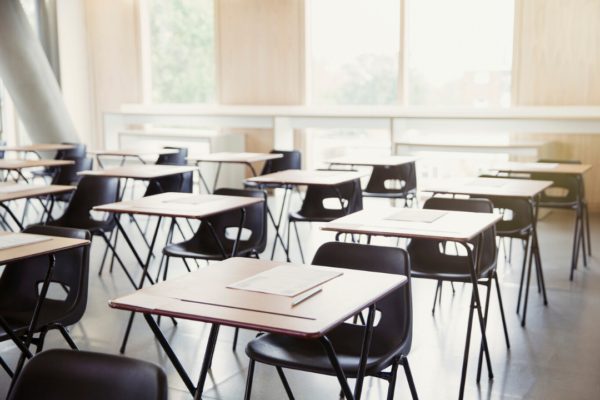
| Date | Author |
|---|---|
| 17th February 2022 | Dr Hiral Patel, Lecturer in the Welsh School of Architecture, Cardiff University |
Given that a higher education institution's (HEI's) core aim is to deliver learning, you might expect a strong body of knowledge on the relationship between learning and teaching space in universities. However, that is, unfortunately, not the case.
Here, SUMS Academic Partner Dr Hiral Patel, Lecturer in the Welsh School of Architecture at Cardiff University, outlines the current challenges to getting this alignment right, and shares initial research and a resulting tool from a pilot project on aligning learning with the space in which it takes place.
A Typical Day in the Classroom
A lecturer arrives in her class on a Tuesday afternoon with a lot of excitement. She has prepared a debate session where 40 students will be working in smaller groups to develop their critical thinking and communication skills. The classroom has a capacity of 40 students. It is laid out in lecture-style rows, which is its standard configuration. She thinks about changing the layout so that students could sit in groups. However, the tables are too heavy for her to lift and so are the chairs. Given the short duration of the class (only 50 minutes), there is no time to waste rearranging the furniture. Even if she sought help from some of the early arriving students, there is no space to do so.
As more students start arriving, some of them turn around the chairs to form a group, while others sit as a group in a row. Bags are put on the floor, coats on the chairs and phones emerge out of the pockets. Some students have laptops while others have notepads. The tidy layout of the classroom in rows turns feral. The lecturer and students get stuck into the session and the classroom disappears into the background. It is not long before the classroom re-emerges into the foreground. The lecturer attempts to move between the groups. But she struggles to get near to a few students who are sitting in the corner of the room. She leaps over bags on the floor while being conscious of not catching her foot in one of the bags. Amidst all this, she wishes the classroom was slightly bigger and was configured to match her session.
Challenges in aligning learning and teaching spaces in universities are common and manifest in different forms. For example, it could include struggles to make expensive and sophisticated audio-visual equipment work – we’ve all been there! The delivery of a pedagogically innovative session could be impoverished due to a classroom that is not aligned to those needs.
Achieving alignment between learning and space has been a long-standing matter of concern. In 2007, following an in-depth review of literature on higher education learning spaces, Paul Temple concluded that:
“… connection between day-to-day premises maintenance and learning may need to be drawn to the attention of institutional managements. It seems that small things may make a big difference to learning, rather than, necessarily, grand architectural statements”.
A decade and a half later, in the context of the COVID-19 pandemic, Ian Taylor calls for architectural interventions based on an integrative approach, linking learning spaces and teaching/learning styles.
How Easy is it to Align Learning and Space in Universities? Answer: Not easy at all.
It is difficult to align learning and space in universities for three key reasons:
Conceptual dogma
Learning is not bound between the four walls of the classroom or during the contact hours with tutors. Understanding the use of spaces for learning outside timetabled hours – on-demand learning spaces – is becoming critical. A strategic campus-wide approach is required which spans timetabled and on-demand spaces. A building as a conceptual unit is redundant. Moreover, a range of learning spaces is required to suit different learning activities. For example, there is a growing demand for quiet study spaces for groups and individuals, which are in danger of getting sidelined amidst the major trend to increase collaborative group workspaces.
Fragmented processes
Alignment between learning and space is not a one-off activity to be conducted when starting new building projects. It requires continuous effort and ongoing attention. Procurement systems, governance processes, management tools and organisational practices need to reflect the continuous nature of the alignment activity.
Organisational silos
Our Aligning Learning and Space Survey conducted in 2021 (and which you can read about further in the briefing paper below) revealed that the capabilities for aligning learning and teaching space in universities are dispersed across an institution. Moreover, the design and management of learning spaces need to bring together education/academic developers, IT specialists and Estates professionals. Staff at the front-line of the delivery need to be supported with tools and capabilities to inform the development of learning spaces and adjust existing spaces to suit their curriculum design. Last, but not in any way least, the lessons learnt from students’ experience of their curriculum is integral in shaping estate interventions.
How Can We Better Align Learning and Space for a Better Student Experience?
There have been many calls to develop our understanding of interactions between learning activities and learning spaces, as well as building capabilities to achieve an alignment between learning and teaching space in universities. Within this context and given the challenges above, we developed and distributed the aligning learning and space survey to map the current state of skills, capabilities, resources, and processes within HEIs. The aim was to understand how to align curriculum and learning activities with physical spaces. While there was a limited response rate, the results from the survey do offer insights into a few key themes (you can read more about this in the Briefing Paper below).
In response to the emerging themes from the survey, we developed the Learning-Space Aligner Tool, which aims to provide a first step in creating an action plan for change. The tool is based on the research that I have been conducting in the higher education sector for the last decade. It does not claim to be a magic wand that will make all the problems go away. It is rather a friend that can aid to bring together key stakeholders to have a progressive conversation.
If you would like to find out more, you can read the SUMS Briefing Paper: The Co-Evolution of Pedagogy and Learning Spaces for a Better Student Experience.
SUMS works with universities across the UK to support informed and effective curriculum development and space management. For support in this area, please contact SUMS Managing Consultant Claire Taylor MBE at s.c.taylor@reading.ac.uk.








